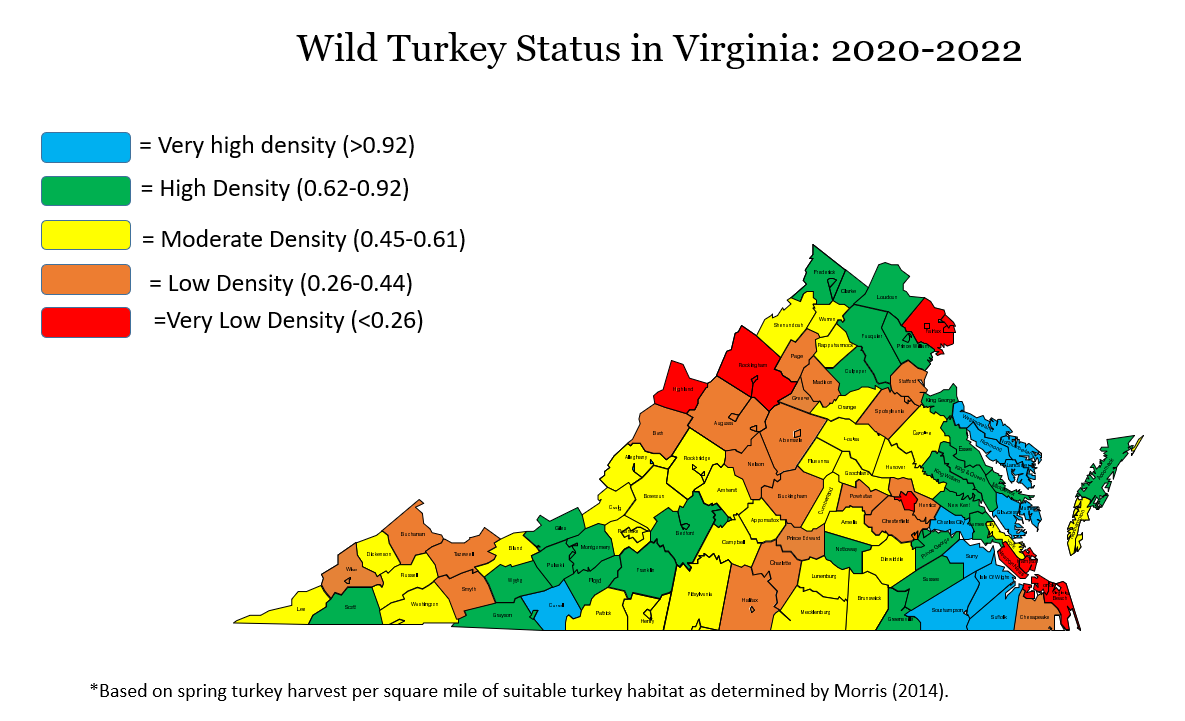By Bruce Ingram
Photos by Bruce Ingram
As is often the case with all things hunting, Virginia’s upcoming spring gobbler season offers a mixture of good and bad news. Virginia Department of Wildlife Resources (DWR) Upland Game Bird Biologist Mike Dye believes that hunters should expect solid action; however, turkey numbers have declined in pockets over the past half decade or so.
“Generally, 2-year-old gobblers make up the bulk of the harvest,” he said. “They gobble the most, and are also the age group most likely to come to calls. In 2021, we had a relatively good poult per hen (pph) ratio of 2.7, which was much better than the 2020 and 2022 pph ratios, each of which was 1.9.
“There is a caveat with the 2020 figure, though. That year was the beginning of the pandemic, and staff drove fewer miles looking for birds, which definitely affected the number of sightings. But the reality is that there probably won’t be as many 3-year-olds and jakes around this spring.”
Dye believes the turkey population decline is not because our birds are being overhunted or because of coyotes and other predators.
“Mortality from weather is the number one killer of turkeys, specifically poults under two weeks of age,” he said. “Poults can’t fly up to roost until they are from 10 days to two weeks old. And for the past several springs during that time of vulnerability, we’ve had unseasonably, cold, wet rains. The change in weather patterns and the ill-timed weather events do appear to be linked to changes in the overall climate.
“This isn’t unique to Virginia,” Dye continued. “States all over the Southeast are experiencing the same population changes, and now it’s starting to spread to the Northeast states as well. Some people like to blame the population declines on raccoons and coyotes. But the last 20 years, we haven’t seen a population increase in raccoons, and studies show that coyotes actually may have a positive effect on turkey populations because they prey on some of our nest predators. Hunters often report that they’ve seen coyotes stalking or chasing turkeys. But coyotes are usually about as successful catching healthy, adult turkeys as my dog is catching squirrels in my backyard.”
Around the state, the biologist believes the Tidewater region continues to offer the best turkey hunting because of the region’s patchwork of woodlots and agricultural areas. The mosaic-type habitat in our flatlands is ideal for this big game bird. Runner-up in the turkey parade is the Southwest Mountain region. This area is basically from Blacksburg to the Tennessee line with the band of counties along the Kentucky border (Scott, Wise, and Dickinson) being the outlier as turkey numbers there are lower.

The South Piedmont (Nottaway, Lunenburg, Brunswick, Campbell, and Pittsylvania area) ranks third. Elsewhere, the Northern Mountain region continues to harbor fewer birds. This is basically the swath of counties from Botetourt to Rockingham County. The counties in the Northern Piedmont (Fauquier, Loudoun, and Culpeper) are making some significant increases as are several of the counties in the northern Shenandoah Valley (Frederick, Clarke, and Shenandoah).
Youth and Apprentice Hunter Weekend will be April 1 and 2 this year (with the regular season beginning April 8). Dye said participation in this weekend seems to have stabilized, with harvests the past two years being 651 and 613, respectively. In 2022, hunters could pursue gobblers all day an extra week, and that caused the afternoon kill to increase from 4 to 8 percent.
Overall, the afternoon harvest only made up 8 percent of the total harvest, but it made up 17 percent of the week three kill, 23 percent of week four’s, and 28 percent of week five’s. The biologist speculates that the relatively high afternoon harvest in week five came from hardcore hunters who were trying to tag a bird before the season ended. This spring all-day hunting begins April 24, and the season runs through May 13.
So, pattern your guns, conduct some scouting, and practice your calling. Virginia’s spring gobbler season is right around the proverbial corner.


